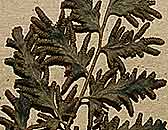Lygodium Sw.
Photo: P. Ballings
Zimbabwe
Description of the genus
Plants terrestrial, climber. Rhizome horizontal creeping, slender, dichotomously branched. Fronds climbing, numerous, dimorphic, specialised fertile pinnae with strongly reduced lamina parts bearing aggregated sporangia in marginal spike-like masses; with a slender twisting indeterminate rhachis, stipe cylindric, rhachis cylindrical to slightly flattened adaxially. Indumentum composed of single uniseriate hairs confined to the frond axes and veins, veins free. The climbing stem is in fact the stipe and the rhachis of an elongated frond. Secondary rhachis branches absent or present, alternate, dichotomously branched, with an arrested apical bud in each bifurcation. Pinnae borne in pairs along the secondary rhachis. Pinnae pinnate to 3-pinnatifid. Sporangia borne along the margins of pinnule lobes, borne seperately in 2 rows at the veins endings, each sporangium subtended by an indusia-like flange covering it abaxially, homosporous.
Derivation of name: Lygodes: flexible, twining; a reference to the climbing nature of these ferns.
Worldwide: c. 40 species, pantropical and temperate distribution
We have 4 taxa in the database for Lygodium.
Literature
